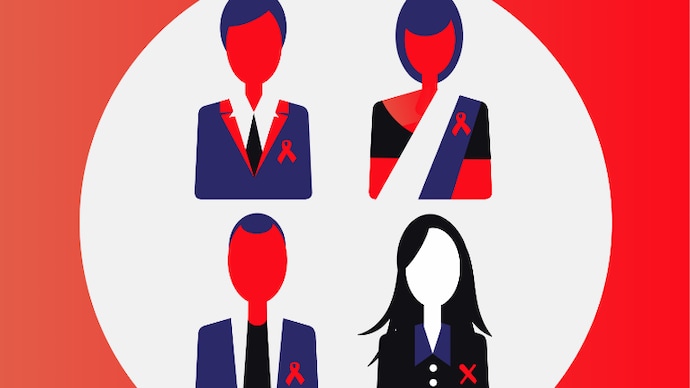World AIDS Day 2018: Theme, awareness slogans, history, key facts
Do you know when the iconic red ribbon that represents fighting HIV/AIDS was conceptualised? Find out all about HIV/AIDS this World AIDS Day 2018.

Today, that is December 1 2018, World Health Organisation (WHO) joins global partners and citizens to commemorate AIDS Day under the theme 'Know Your Status'.
This is also an occasion to celebrate the 30th anniversary of World AIDS Day -- a pioneering global health campaign first initiated by WHO in 1988.
2 objectives of the theme of AIDS Day 2018
It is estimated that currently only 75 per cent of people with HIV know their status.
WHO advocacy and communication for World AIDS Day 2018 with the theme 'Know Your Status' aims to achieve the following objectives:
- Urge people to know their HIV infection status through testing, and to access HIV prevention, treatment and care services
- Urge policy-makers to promote a 'health for all' agenda for HIV and related health services, such as tuberculosis (TB), hepatitis and non-communicable diseases
7 slogans on AIDS Day
"HIV does not make people dangerous to know, so you can shake their hands and give them a hug: Heaven knows they need it" -Princess Diana
One in four people with HIV don't know they have it; know your risks= know your status
Prevention is better than cure; especially when something has no cure
The risk is not knowing; stop AIDS
Safe sex or no sex; it's your life that's at stake
Hate the disease, but not the diseased!
Are few minutes of unprotected thrills, worth a lifetime of pills?
History of World AIDS Day: A timeline
At the beginning of the 1980s, before HIV had been identified as the cause of AIDS, the infection was thought to only affect specific groups, such as gay men in developed countries and people who inject drugs.
The HIV virus was first isolated by Dr Francoise Barre-Sinoussi and Dr Luc Montagnier in 1983 at the Institut Pasteur.
In November that year, WHO held the first meeting to assess the global AIDS situation and initiated international surveillance.
With increasing awareness that AIDS was emerging as a global public health threat, the first International AIDS Conference was held in Atlanta in 1985.
MSF is gearing up for World Aids Day on 1 December. Our #HIV projects across the world are hosting events to highlight MSF's work with people living with HIV. Follow us to find out how MSF is reflecting on the fight against HIV/AIDS #WAD2018 #WorldAidsDay pic.twitter.com/I9sKcjkVVT MSF HIV (@MSF_HIV) November 28, 2018
In 1988, two WHO communications officers, Thomas Netter and James Bunn, put forward the idea of holding an annual World AIDS Day, with the aim of increasing HIV awareness, mobilising communities and advocating for action worldwide.
It wasn't until 1991 that the HIV movement was branded with the iconic red ribbon. This was the very first disease-awareness ribbon, a concept that would later be adopted by many other health causes.
Clinical trials of antiretrovirals (ARVs) began in 1985 -- the same year that the first HIV test was approved -- and the first ARV was approved for use in 1987.
By 1995, ARVs were being prescribed in various combinations.
Generic manufacturing of ARVs would only start in 2001 providing bulk, low-cost access to ARVs for highly affected countries, particularly in sub-Saharan Africa, where by 2000, HIV had become the leading cause of death.
Also read | Parliament passes the HIV/AIDS Bill: All you need to know
7 key facts on HIV/AIDS
1. HIV continues to be a major global public health issue, having claimed more than 35 million lives so far.
2. In 2017, 9,40,000 people died from HIV-related causes globally.
3. There were approximately 36.9 million people living with HIV at the end of 2017 with 1.8 million people becoming newly-infected in 2017 globally.
4. The WHO African Region is the most affected region, with 25.7 million people living with HIV in 2017.
5. The African region also accounts for over two thirds of the global total of new HIV infections.
6. Key populations often have legal and social issues related to their behaviours that increase vulnerability to HIV and reduce access to testing and treatment programmes.
7. Between 2000 and 2017, new HIV infections fell by 36 per cent, and HIV-related deaths fell by 38 per cent with 11.4 million lives saved due to ART in the same period.
Also read | India home to 46.6 million stunted children, a third of world's total: Global Nutrition Report 2018
Interested in General Knowledge and Current Affairs? Click here to stay informed and know what is happening around the world with our G.K. and Current Affairs section.
To get more updates on Current Affairs, send in your query by mail to education.intoday@gmail.com
